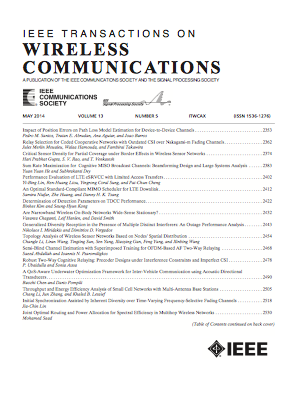具有盲均衡和复值神经接收器的可重构智能曲面生成的爱森斯坦星座鲁棒媒体调制
IF 10.7
1区 计算机科学
Q1 ENGINEERING, ELECTRICAL & ELECTRONIC
引用次数: 0
摘要
最近的研究提出了基于媒体的调制(MBM)作为一种方法来降低无线通信系统的硬件复杂性,从而也实现了相关成本的降低。在这项工作中,我们提出了一种基于缩放和移位的爱森斯坦整数组成的新型非对称信号星座的MBM系统。星座是由可重构智能天线引起的相移产生的,其中大小通过打开或关闭一定数量的反射元件来调制。在接收端,采用均匀线性天线阵列捕获入射电磁波。采用稳健估计技术,如中位数、Weiszfeld算法和$S_{q}$ -估计器来恢复星座点。提出了一种新的增益控制方案和基于圆互相关的相位偏移检测方法。此外,采用复值卷积神经网络作为解码器。除了加性高斯白噪声外,我们还考虑了系统在电压瞬变引起的脉冲噪声下的性能,并通过-Ã -采用通用64-QAM调制方案和基于四象限arctan函数和中位数的暴力算法显示了优越的性能。此外,我们还比较了该系统与六边形QAM-MBM和QAM-MBM的性能。本文章由计算机程序翻译,如有差异,请以英文原文为准。
Robust Media-Based Modulation With an Eisenstein Constellation Generated by a Reconfigurable Intelligent Surface With Blind Equalization and Complex-Valued Neural Receivers
Recent research has proposed media-based modulation (MBM) as a method to reduce the hardware complexity of wireless communications systems and therefore also achieve a reduction of the associated cost. In this work, we propose an MBM system based on a novel asymmetric signal constellation consisting of scaled and shifted Eisenstein integers. The constellation is generated by phase shifts induced by a reconfigurable intelligent antenna, where the magnitudes are modulated by turning on or off certain numbers of reflecting elements. At the receiver, a uniform linear antenna array is used to capture the incident electromagnetic planar wave. Robust estimation techniques, such as the median, the Weiszfeld algorithm, and the $S_{q}$ -estimator are employed to recover the constellation points. A novel gain control scheme is proposed together with a phase offset detection method based on circular cross-correlation. Furthermore, complex-valued convolutional neural networks are used as decoders. We consider the performance of our system under impulse noise caused by voltage transients in addition to additive white Gaussian noise and show superior performance vis-Ã -vie a generic 64-QAM modulation scheme and a brute-force arithmetic method based on the four-quadrant arctan function and the median. Furthermore, we compare our system performance with hexagonal QAM-MBM and QAM-MBM.
求助全文
通过发布文献求助,成功后即可免费获取论文全文。
去求助
来源期刊
CiteScore
18.60
自引率
10.60%
发文量
708
审稿时长
5.6 months
期刊介绍:
The IEEE Transactions on Wireless Communications is a prestigious publication that showcases cutting-edge advancements in wireless communications. It welcomes both theoretical and practical contributions in various areas. The scope of the Transactions encompasses a wide range of topics, including modulation and coding, detection and estimation, propagation and channel characterization, and diversity techniques. The journal also emphasizes the physical and link layer communication aspects of network architectures and protocols.
The journal is open to papers on specific topics or non-traditional topics related to specific application areas. This includes simulation tools and methodologies, orthogonal frequency division multiplexing, MIMO systems, and wireless over optical technologies.
Overall, the IEEE Transactions on Wireless Communications serves as a platform for high-quality manuscripts that push the boundaries of wireless communications and contribute to advancements in the field.

 求助内容:
求助内容: 应助结果提醒方式:
应助结果提醒方式:


